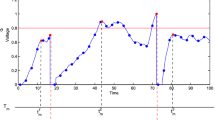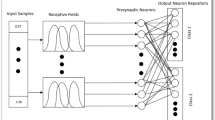Abstract
Spiking neural networks (SNNs) process information with temporal coding schemes to transmit feature values into spiking time series. Population Coding (PC) is the most popular scheme, but it fixes static coding parameters and cannot realize the intelligent transformation of information. This paper proposes a new Adaptive Fuzzy Population Coding (AFPC) method, where parameters are optimized synchronously with SNN weights by the learning algorithm to realize coding adaptation. Because the membership function defined in the fuzzy theory is a generalization of the indicator function for classical sets, the receptive field functions used in AFPC are extended to intermediate membership functions instead of a single Gaussian type as in PC. The optimized receptive field functions in AFPC can be really involved in coding, so that the distribution information of training data represented in the spiking time series is more abundant. Numerical experimental results obtained on four benchmark datasets show that AFPC-SNN performs well in terms of classification performance, required number of epochs, generalization and stability. AFPC method can be theoretically and practically applicable to any SNN with SpikeProp algorithm.







Similar content being viewed by others
References
Liu, F., Yang, J., Pedrycz, W., Wu, W.: A new fuzzy spiking neural network based on neuronal contribution degree. IEEE Trans. Fuzzy Syst. (2021). https://doi.org/10.1109/TFUZZ.2021.3090912
Tavanaei, A., Ghodrati, M., Kheradpisheh, S.R., Masquelier, T., Maida, A.: Deep learning in spiking neural networks. Neural Netw. 111, 47–63 (2019)
Davies, M., Srinivasa, N., Lin, T.H., Chinya, G., Cao, Y., Choday, S.H., Wang, H.: Loihi: a neuromorphic manycore processor with on-chip learning. IEEE Micro 38(1), 82–99 (2018)
Mostafa, H.: Supervised learning based on temporal coding in spiking neural networks. IEEE Trans. Neural Netw. Learn. Syst. 29(7), 3227–3235 (2017)
Pan, Z., Wu, J., Zhang, M., Li, H., Chua, Y.: Neural population coding for effective temporal classification. In: 2019 International Joint Conference on Neural Networks (IJCNN), pp. 1–8 (2019)
Zhang, T., Jia, S., Cheng, X., Xu, B.: Tuning convolutional spiking neural network with biologically plausible reward propagation. IEEE Trans. Neural Netw. Learn. Syst. (2021). https://doi.org/10.1109/TNNLS.2021.3085966
Neftci, E.O., Mostafa, H., Zenke, F.: Surrogate gradient learning in spiking neural networks: bringing the power of gradient-based optimization to spiking neural networks. IEEE Signal Process. Mag. 36(6), 51–63 (2019)
Srivastava, K.H., Holmes, C.M., Vellema, M., Pack, A.R., Elemans, C.P., Nemenman, I., Sober, S.J.: Motor control by precisely timed spike patterns. Proc. Natl. Acad. Sci. 114(5), 1171–1176 (2017)
Engel, A.K., König, P., Kreiter, A.K., Schillen, T.B., Singer, W.: Temporal coding in the visual cortex: new vistas on integration in the nervous system. Trends Neurosci. 15(6), 218–226 (1992)
Kim, J., Kim, H., Huh, S., Lee, J., Choi, K.: Deep neural networks with weighted spikes. Neurocomputing 311, 373–386 (2018)
Park, S., Kim, S., Choe, H., Yoon, S.: Fast and efficient information transmission with burst spikes in deep spiking neural networks. In: 2019 56th ACM/IEEE Design Automation Conference (DAC), pp. 1–6 (2019)
Guo, W., Fouda, M.E., Eltawil, A.M., Salama, K.N.: Neural coding in spiking neural networks: a comparative study for robust neuromorphic systems. Front. Neurosci. 15, 212 (2021)
Hopfield, J.J.: Pattern recognition computation using action potential timing for stimulus representation. Nature 376(6535), 33–36 (1995)
Eurich, C.W., Wilke, S.D.: Multidimensional encoding strategy of spiking neurons. Neural Comput. 12(7), 1519–1529 (2000)
Averbeck, B.B., Latham, P.E., Pouget, A.: Neural correlations, population coding and computation. Nat. Rev. Neurosci. 7(5), 358–366 (2006)
Bohte, S.M., Kok, J.N., La Poutre, H.: Error-backpropagation in temporally encoded networks of spiking neurons. Neurocomputing 48(1–4), 17–37 (2002)
Baldi, P., Heiligenberg, W.: How sensory maps could enhance resolution through ordered arrangements of broadly tuned receivers. Biol. Cybern. 59(4), 313–318 (1988)
Ezzyat, Y., Kragel, J.E., Burke, J.F., Levy, D.F., Lyalenko, A., Kahana, M.J.: Direct brain stimulation modulates encoding states and memory performance in humans. Curr. Biol. 27(9), 1251–1258 (2017)
Tian, E., Babanezhad, M., Rezakazemi, M., Shirazian, S.: Simulation of a bubble-column reactor by three-dimensional CFD: multidimension-and function-adaptive network-based fuzzy inference system. Int. J. Fuzzy Syst. 22(2), 477–490 (2020)
Faria, F.A., Silva, G.N., Oliveira, V.A.: Reducing the conservatism of LMI-based stabilisation conditions for TS fuzzy systems using fuzzy Lyapunov functions. Int. J. Fuzzy Syst. 44(10), 1956–1969 (2013)
Bloch, I.: Fuzzy sets for image processing and understanding. Fuzzy Sets Syst. 281, 280–291 (2015)
Hodgkin, A.L., Huxley, A.F.: A quantitative description of membrane current and its application to conduction and excitation in nerve. J. Physiol. 117(4), 500 (1952)
Stein, R.B.: Some models of neuronal variability. Biophys. J. 7(1), 37–68 (1967)
Kistler, W.M., Gerstner, W., Hemmen, J.L.V.: Reduction of the Hodgkin-Huxley equations to a single-variable threshold model. Neural Comput. 9(5), 1015–1045 (1997)
Sambariya, D.K., Prasad, R.: Selection of membership functions based on fuzzy rules to design an efficient power system stabilizer. Int. J. Fuzzy Syst. 19(3), 813–828 (2017)
Wade, J.J., McDaid, L.J., Santos, J.A., Sayers, H.M.: SWAT: a spiking neural network training algorithm for classification problems. IEEE Trans. Neural Netw. 21(11), 1817–1830 (2010)
Wang, J., Belatreche, A., Maguire, L., McGinnity, T.M.: An online supervised learning method for spiking neural networks with adaptive structure. Neurocomputing 144, 526–536 (2014)
Dora, S., Sundaram, S., Sundararajan, N.: A two stage learning algorithm for a growing-pruning spiking neural network for pattern classification problems. In: 2015 International Joint Conference on Neural Networks (IJCNN), pp. 1–7 (2015)
Dora, S., Subramanian, K., Suresh, S., Sundararajan, N.: Development of a self-regulating evolving spiking neural network for classification problem. Neurocomputing 171, 1216–1229 (2016)
Dora, S., Sundaram, S., Sundararajan, N.: An interclass margin maximization learning algorithm for evolving spiking neural network. IEEE Trans. Cybern. 49(3), 989–999 (2018)
López-Vázquez, G., Ornelas-Rodriguez, M., Espinal, A., Soria-Alcaraz, J.A., Rojas-Domnguez, A., Puga-Soberanes, H.J., Rostro-Gonzalez, H.: Evolutionary spiking neural networks for solving supervised classification problems. Comput. Intell. Neurosci. 2019, 4182639 (2019)
Machingal, P., Thousif, M., Dora, S., Sundaram, S.: Self-regulated learning algorithm for distributed coding based spiking neural classifier. In: 2020 International Joint Conference on Neural Networks (IJCNN), pp. 1–7 (2020)
Xie, X., Liu, G., Cai, Q., Qu, H., Zhang, M.: The maximum points-based supervised learning rule for spiking neural networks. Soft Comput. 23(20), 10187–10198 (2019)
Peng, Y., Zhang, Q.: Uncertainty measurement for set-valued data and its application in feature selection. Int. J. Fuzzy Syst. 24(3), 1735–1756 (2022)
Hoffer, E., Hubara, I., Soudry, D.: Train longer, generalize better: closing the generalization gap in large batch training of neural networks. In: 31st Conference on Neural Information Processing Systems (NIPS 2017), Long Beach, CA, USA (2017)
Acknowledgements
This work was supported by the National Key R&D Program of China under Grant 2018AAA0100300, the Fundamental Research Funds for the Central Universities under Grant DUT22YG236, and the National Natural Science Foundation of China under Grant 11201051, 62172073, 62076182.
Author information
Authors and Affiliations
Corresponding author
Rights and permissions
Springer Nature or its licensor holds exclusive rights to this article under a publishing agreement with the author(s) or other rightsholder(s); author self-archiving of the accepted manuscript version of this article is solely governed by the terms of such publishing agreement and applicable law.
About this article
Cite this article
Liu, F., Zhang, L., Yang, J. et al. Adaptive Fuzzy Population Coding Method for Spiking Neural Networks. Int. J. Fuzzy Syst. 25, 670–683 (2023). https://doi.org/10.1007/s40815-022-01395-9
Received:
Revised:
Accepted:
Published:
Issue Date:
DOI: https://doi.org/10.1007/s40815-022-01395-9




